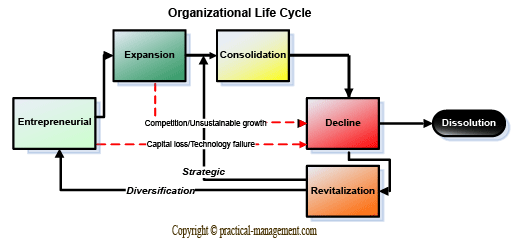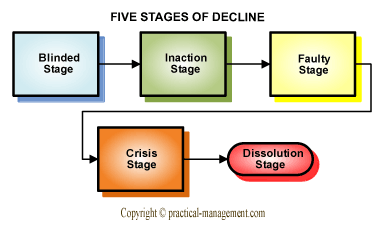Discusses the life-cycle of an organization, its growth stages and its eventual decline.
Organizational Life-cycle & Decline
An organization undergoes changes in its conceptual and structural dimensions over a period of time, analogous to biological organisms, it is born, and it attains growth, gets matured and eventually dies. Most research on life-cycle suggest three major growth stages and a decline stage, each has its own conceptual variations and they result in observable change in structure and vision.
Entrepreneurial stage
It is the conceptual stage where the new product is defined, its market is identified and development plan is executed.
- Leadership Focus is on successful development of prototype or marketable product, while able to manage the necessary finance.
- Organization size is small, its reporting structure is flat and non-bureaucratic, and founder bears the responsibility of managing all aspects of the organization.
- The culture is informal, promotes innovation and risk-taking, the decision making is centralized and mostly lies with the founder, long working hours are expected.
- The specialization and growth are limited to the core functionalities like R&D, manufacturing or service. The staff is usually highly skilled with relevant experience in the core functions and the supporting staff is minimal.
- Individual effectiveness is most important at this stage.
Expansion
The organization emerges from entrepreneurial stage if it succeeds in its initial goal of product creation and had secured finance and perhaps few customers. It then enters the commercialization stage where it has to build the product in larger quantities, reach wider customers and become a profitable venture.
- Leadership focus is on making the product work well and to increase the sales and revenue.
- The organization size needs to grow since it needs more resources for larger production and sales. While a consistent growth in core functionality continues, additional growth occurs in sales and marketing.
- The culture gets inclined towards market culture since external environment is for the time being stable, the entrepreneurial success provides some buffer time before competition emerges on the horizon.
- Organization structure starts its initial shift towards being more hierarchical; the founder is incapable for managing everything and starts delegating tasks to his subordinates creating management hierarchies. Since the expansion is particularly in R&D and sales, the supporting staff is still minimal; the organization adopts a functional structure.
- The organizational growth brings in more specialist and subordinates through hiring, it inadvertently creates a leadership crisis at the top level since the changed organization demands delegation of responsibility. All the initial founders and the individual technical leads need to part with their autonomous powers that they enjoyed during the entrepreneurial phase and learn to delegate decision making and perform the new task of coordination and team building. Middle management evolves and is responsible for operations while the top management focuses on business strategies.
- The management processes began to emerge in the activities related to production and control, though they are still not very well defined and are still flexible.
- Leadership challenge is to constantly scan the external environment for competition and hostility while it is so much focused on the growth.
Consolidation
The expansion phase results in an expanded operation related to production like purchasing, inventory control, etc and also diversely deployed sales staff. The organization was geared towards maximizing its production and sales capacity. In consolidation stage, the focus shifts towards cost control, productivity and profit.
- The leadership focus is on achieving the organizational effectiveness.
- The organization size is almost stable, the expansion stage might have lead to some redundancies in core functions, but consolidation stage might include additional manpower in supporting functions. The growth can occur in additional staff related to quality control, customer support, administrative functions and marketing. Unlike growth stage when the size increases linearly, the consolidation stage involves both downsizing and hiring.
- There is an increase in number of products, even though they might be still related to the core competencies; as a consequence, the organizational structure becomes divisional with more departments.
- The organization’s culture becomes bureaucratic due to high degree of formalization and processes that are deemed necessary as a way to better control the operations.
- The leadership challenge is to establish seamless communication protocol between different departments, look for signs of external environmental changes and make necessary corrective actions.

Decline
An organization enters the decline phase when it experiences continuous reduction in resources and revenue over a substantial period of time. Ironically, the decline can be recognized with certainty only when it is too late to recover from it, early signs are often mistaken to be temporary. The decline can occur after any growth stage, not necessarily after consolidation stage; also growth does not always lead to decline, there is also possibility of long period of stagnation.
Stagnation can be defined as a state with no growth, fewer but dedicated customers, few competitors, a niche market or availability of abundant resources. Stagnation does not usually result in loss of revenues or downsizing.
Reasons for decline
There are several causes of decline, some are quantitative and are easier to detect while other are qualitative and are hard to comprehend. The decline can be due to adverse changes in the external environment or inefficiencies pertaining to internal operations of the organization.
Quantitative reasons of decline
The quantitative analysis can be found in the organization’s financial statements, its internal operation reports and by using other mathematically measurable parameters.
- Reduced workforce: A cutback in size of the organization reflects a reduced total market, reduced need of products; lack of capability to deliver the product, hence the underlying reasons implies a decline. However, there are times when cutback is a temporary measure to realign and revitalize the organization for another phase of growth.
- Reduced market share: The reduction in the market share of the company implies several issues, growing competition if the total market is indeed growing or is stable, or contraction of overall market due to obsolete products or technologies.
- Reduced profit or share price: It provides the investor’s assessment of the companies operating margin and its prospects of growth in future.
Qualitative reasons of decline
- Fierce competition: During the entrepreneurial stage, the big players might try all tools in their arsenal to counter the threat of a newcomer. It includes practices of aggressive pricing, luring their established client base with bonus deals, acquisition of competitive technologies and developing parallel products etc. Many times, the hostile takeover by large and established company is for the purpose of quick termination of a competitor.
- Lack of Customers: It happens due to unexpected decline in the niche market, a change in consumer’s choice for a different product or simply because the organization fails to find proper market for the product. It can happen at any stage of life-cycle, the quarterly sales and revenue over a period of time are good indicators of change in customer base.
- Obsolete technology: Older organizations are very much vulnerable to newer technologies that can adversely impact its core business and competencies.
- Economic downfall: Harsh economic environment reduces the customer spending; multiple vendors compete for the reduced market share. It also gets hard to obtain fresh credit and finances for new ventures or existing operations.
- Organizational atrophy: It usually occurs in older organizations that have experienced healthy growth & long period of stability; the hierarchical structure & the bureaucratic culture of such large organization cause its slow degeneration. The organization size is large with excessive personnel, middle management is incumbent that tolerates incompetence, management processes are excessive and counterproductive; finally there is a leadership crisis. Employees loose trust in the leadership and its vision; the employee satisfaction level starts to dip consistently and so does its operational efficiency.
A Model of decline stages
Decline of an organization occurs in a series of observable and distinct stages, each exhibiting a reduced capability to counteract. The most acknowledged model of decline proposes that the organization goes through five stages of decline, before its final termination.

Blinded Stage
In this stage, the organization fails to recognize any of the internal or external changes that may threaten its survival. Usually, causes for the decline are present but are not evident; the leadership tends be insensitive and simply fails to make a connection between the observed changes and a possible decline. Most organizations lack a unit that performs the task of scanning both internal & external boundaries, partly due to additional cost and uncertain advantage. The mere concept of a stable environment is a myth and exists only as a theoretical concept; environment is stable only for short duration. Similarly the need for internal surveillance cannot be ignored; it includes regular performance reviews, employee satisfaction surveys, training and skill development, and most importantly an open communication mechanism to aid in vertical flow of information. The initial signs of decline are usually very much visible and known to the bottom of the organizational pyramid, but the information fails to propagate upwards to its leaders.
Inaction Stage
Unlike in blinded stage, the signs of deteriorating performance are clearly evident in this stage, but the leadership still fails to take any action. Leaders often view them as temporary changes and instead of interpreting them as a threat, they choose to take `wait and see’ approach, perhaps because this approach has worked in the past. The past successful approaches fail when the current situations are very different, however the leaders always have tendency to follow the planned course and suppress any dissident opinions. Finally, the aging leadership might simply lack the knowledge and insight to comprehend the influence of the changing conditions.
Faulty Action Stage
In this stage, the organization is clearly on its downfall and pressure to take corrective action is very high. The vertical and horizontal information from within the organization and the external environment increases manifolds along with its complexity. The overload of conflicting information & suggestive actions, combined with time pressure, compels the leadership to centralized decision making and they tend to create a biased task force. However, due to high pressure, the decision makers tends to make quick, risky and often fault decisions, that further accelerates the decline. This further reduces the confidence in leadership and many talented employees might end up leaving the organization in anticipation of its fall. Some of the prescribed cure include introduction of new leadership, diversification of core business either though self development or acquisitions and disinvestment in failing product lines.
Crisis Stage
The organization reaches a crisis stage when all prior actions have failed and it becomes obvious that without any major change, its survival is questionable. All the stakeholders, including customers, investors, suppliers and employees begin to distance themselves from the organization and have lost faith in it. At this stage, the organization requires a massive structural change, a new strategy to deal with the external environment and a new ideology to revitalize the ailing organization.
Dissolution Stage
This is the last stage of its demise and is irreversible; it is marked by depletion of its finance, diminished market for its products and exodus of its talented employees. The new leadership and the strategy had failed to revive the business and now their responsibility lies in proper dissolution of the organization and its resources.
